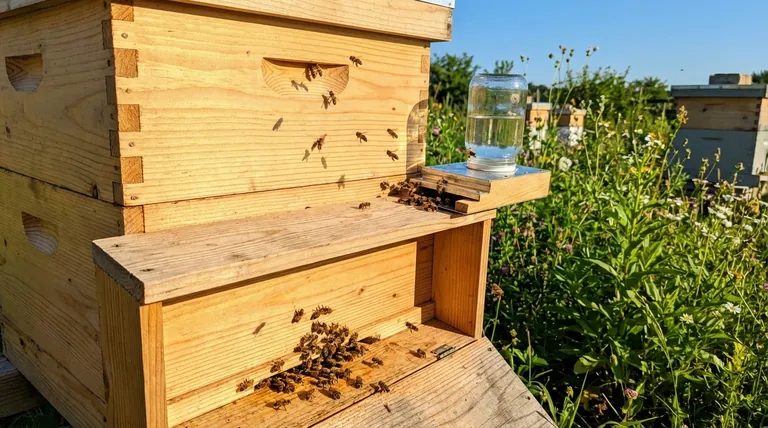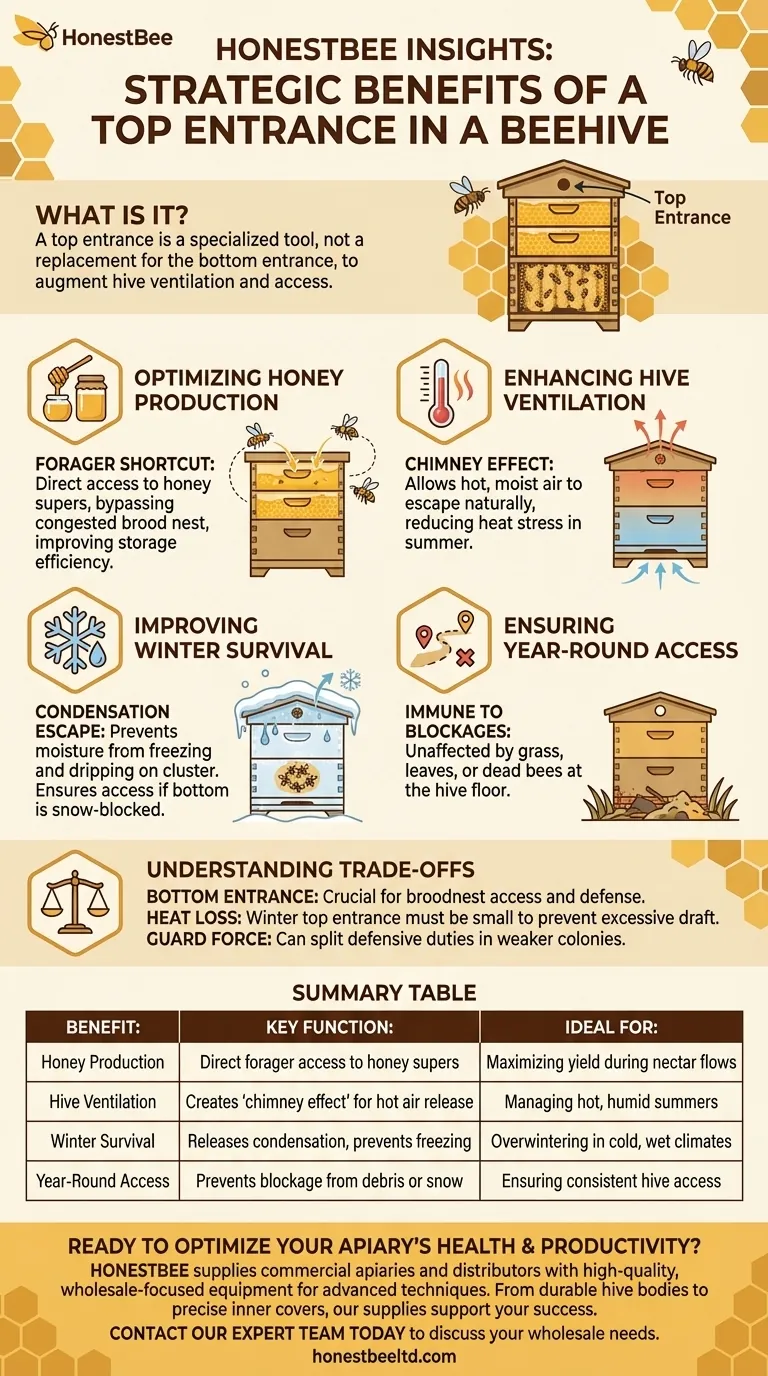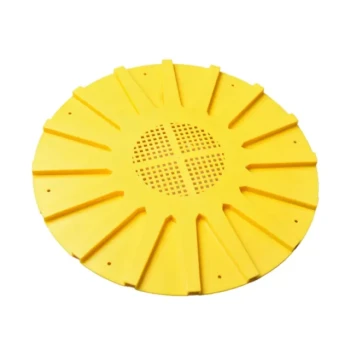In short, a top entrance provides strategic benefits for a beehive. It improves hive ventilation, ensures foragers have direct access to honey supers, and prevents the entrance from being blocked by snow or debris, which is especially critical during winter.
The primary value of a top entrance is not to replace the traditional bottom entrance, but to augment it. It serves as a specialized tool to solve specific environmental and logistical challenges, from managing summer heat to ensuring winter moisture can escape.

The Strategic Advantages of a Top Entrance
A top entrance, often a small hole drilled in an upper hive body or a notch in the inner cover, fundamentally changes how bees and air move through the hive. This creates several distinct advantages depending on the season and your management goals.
Optimizing Honey Production
A key benefit during a strong nectar flow is creating a shortcut for foraging bees.
By providing an entrance directly into the honey supers, foragers can bypass the congested brood nest area below. This can improve the efficiency of honey storage.
Enhancing Hive Ventilation
Proper airflow is critical for the health of the colony, particularly during hot and humid weather.
A top entrance creates a "chimney effect," allowing hot, moist air to escape naturally from the top of the hive. This reduces heat stress and the need for bees to expend energy fanning at the main entrance.
Improving Winter Survival
In cold climates, a top entrance can be a literal lifesaver for a colony.
The primary winter threat inside a hive is not cold, but condensation. As the bee cluster generates heat and moisture, that moisture rises and can freeze on the inner cover, later melting and dripping cold water onto the bees.
A small upper entrance provides a vital escape route for this moisture-laden air, keeping the hive interior drier and healthier. It also ensures the bees have a way out for cleansing flights if the bottom entrance becomes blocked by snow or ice.
Ensuring Year-Round Access
Unlike a bottom entrance, a top entrance is immune to many common blockages.
It cannot be obstructed by overgrown grass, fallen leaves, or an accumulation of dead bees at the hive floor. This guarantees the colony always has a clear path for foraging and ventilation.
Understanding the Trade-offs
While beneficial, a top entrance is not a universal solution and introduces new considerations. It's a modification to the hive's natural design, which centers around a single, defensible bottom entrance.
The Role of the Bottom Entrance
The standard bottom entrance provides foragers with immediate access to the broodnest. This is crucial for feeding larvae and allows guard bees to effectively defend a single, small opening against pests like wasps and robbing bees.
Potential Heat Loss
In winter, a top entrance can sometimes work too well. If the opening is too large, it can allow too much heat to escape from the winter cluster, forcing the bees to consume more honey stores to stay warm.
For this reason, a winter top entrance should be very small—often just a 3/4-inch hole—to allow moisture out without creating a significant draft.
Dividing the Guard Force
An additional entrance can, in theory, split the defensive responsibilities of the guard bees. For a strong, populous colony this is rarely an issue, but a weaker hive may struggle to defend two separate points of entry.
Making the Right Choice for Your Goal
Deciding whether to use a top entrance depends entirely on your climate and beekeeping objectives.
- If your primary focus is maximizing honey yield: Use a top entrance during heavy nectar flows to give foragers a direct path to the supers.
- If your primary focus is overwintering in a cold, wet climate: A small upper entrance is a critical tool for releasing harmful condensation.
- If your primary focus is managing a hot, humid summer: A top entrance significantly improves airflow and reduces heat stress on the colony.
- If your primary focus is simplicity with a strong colony: The traditional single bottom entrance is a proven, effective setup that works well in many moderate climates.
Ultimately, understanding the top entrance as a strategic tool allows you to actively manage your hive's health and productivity.
Summary Table:
| Benefit | Key Function | Ideal For |
|---|---|---|
| Honey Production | Direct forager access to honey supers | Maximizing yield during nectar flows |
| Hive Ventilation | Creates a 'chimney effect' to release hot, moist air | Managing hot, humid summers |
| Winter Survival | Releases condensation to prevent freezing & dripping | Overwintering in cold, wet climates |
| Year-Round Access | Prevents blockage from snow, grass, or debris | Ensuring consistent hive access |
Ready to optimize your apiary's health and productivity? The strategic use of a top entrance is just one part of effective hive management. At HONESTBEE, we supply commercial apiaries and beekeeping equipment distributors with the high-quality, wholesale-focused supplies needed to implement these advanced techniques. From durable hive bodies to precise inner covers, our equipment is built to support your success. Contact our expert team today to discuss your wholesale needs and discover how we can help your operation thrive.
Visual Guide

Related Products
- Boardman Entrance Bee Feeder Durable Galvanized Steel and Wood Construction for Beekeeping
- Professional Hive Front Entrance Bee Feeder
- HONESTBEE Professional Entrance Bee Feeder Hive Nutrition Solution
- Multi-Functional Sliding Hive Entrance for Beekeeping
- Beehive Entrance Discs Plastic Bee Entrance Disc for Bee Hives
People Also Ask
- What types of bee feeders are available for beginners? Start with the Simple Entrance Feeder
- How to make an entrance feeder for bees? A DIY Guide for Safe & Effective Feeding
- How does an entrance feeder work? A Guide to Its Simple Mechanics and Risks
- What is an entrance feeder and how is it used? Avoid the Critical Risk of Robbing
- How do you make an entrance feeder for bees? A Guide to Safe & Effective Hive Feeding



















